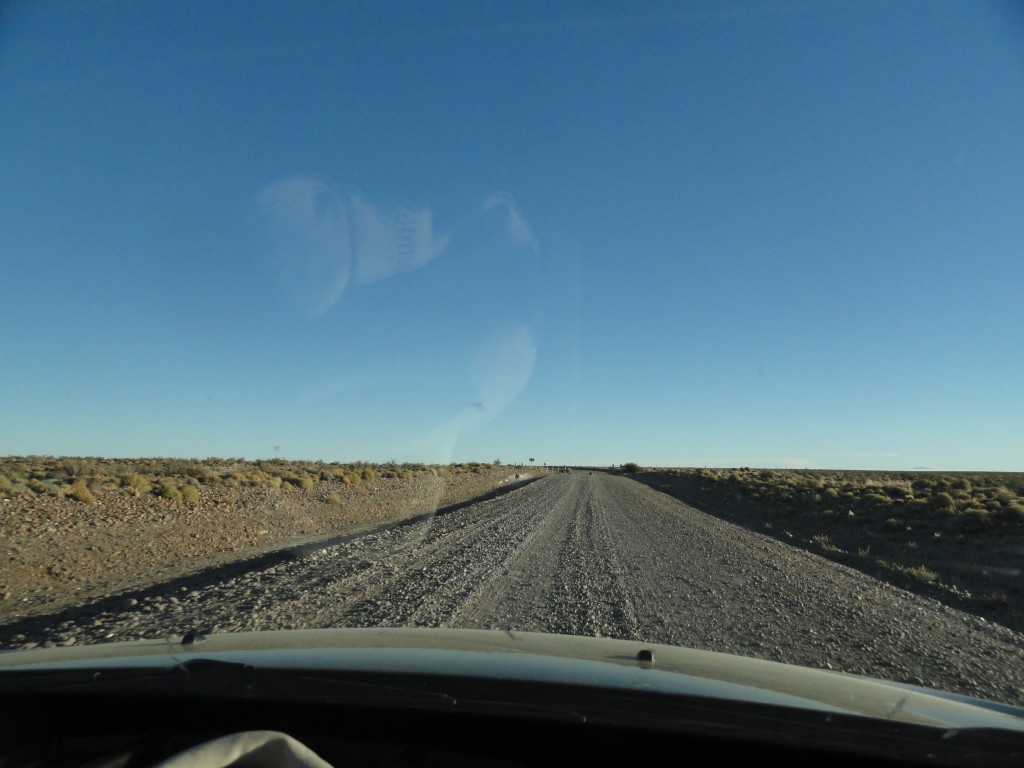Thump.
My leg instinctively jerks away even though this is the tenth time a rock has stung the floorboards beneath my foot. The ping strikes my ears a split second after the thump has stimulated my autonomic reaction. Thump, ping, repeat.
This is Route 40, about 250 km of dirt – no, make that gravel – that Argentina considers a highway. Gravel roads are common here in the southern reaches of Argentina, which is more than can be said for road signs. Except for signs blazing the word “Desvio;” Detour. Desvio signs are ubiquitous along this side of the Patagonian Andes. Detour. The sign itself is obvious, but the road to which you’re detouring to? Well, not so much. We’re pretty much off the grid for the next several days, with hundreds of kilometers between towns, no phone service, no internet, and as I’ve been finding out, often no road.

This is one of the better roads
I’m traveling with my long-time friend and Argentine host, Pablo. Even he has been having difficulty following the road. Desvio signs pop up as routinely as the gravel thumps against the bottom of the car. Several times we had to stop to ask for help locating the road, something that I wouldn’t have been able to do if I was traveling alone. If you don’t speak the language, it’s definitely a plus to be traveling with a native. We actually had to stop to ask the only person we had seen for many miles – the driver of a road grader leveling the mountain of rocks into a semblance of a highway.
Compounding the difficulty was that the gravel roads aren’t captured well on maps. You’ll be driving along a beautifully paved road and suddenly, with no other visible options, another sign pops up – Fin de Pavimento (End of Pavement). I should mention that we’re talking about roads that go on for tens or hundreds of kilometers with no outlets. You’re on this road going one direction, or you’re on it going the other direction. Even then, sometimes you can’t tell which direction you’re going.
Occasionally you’ll suddenly see an opening and get to pop back up onto a partially paved section in the middle of nowhere, but usually that pleasure is short-lived and you’re quickly back on gravel. The road surface ranges from packed dirt and pebbles (a rarity) to looser pebbles (more common) to coarse gravel (even more common) to what the official Krumbein Phi Scale of particle size officially calls cobble. Way too often the road is reminiscent of salmon spawning streams with rocks the size of bricks piled high in the middle of self-made tracks. These are the loudest, and scariest, clanks on the bottom of the car.
The car, by the way, is a Ford EcoSport SUV, so we sit high above the road surface. And still the stones thump.
My foot jerks away again. It actually feels like the rock is a direct strike to the bottom of my shoe.
Gravel roads are common in Pablo’s hometown of Bariloche as well, though mostly at the better end of the spectrum between “noisy but drivable” and “should be condemned as impassible.” So prevalent are gravel roads that Pablo says everyone adds one option to their new car purchase – steel plates on the underside of the car to protect the engine compartment and the gas tanks from puncture.
Thump.
But apparently not the floor boards in the back seat area. It’s a different world down here.
[For more articles on Argentina, click here and scroll down, or simply type Argentina into the search box at the top of the page]
[This is a cross-post from my Hot White Snow site while I’m out science traveling.]
David J. Kent is the author of Tesla: The Wizard of Electricity (2013) and Edison: The Inventor of the Modern World (2016) (both Fall River Press). He has also written two e-books: Nikola Tesla: Renewable Energy Ahead of Its Time and Abraham Lincoln and Nikola Tesla: Connected by Fate. His next book is on Abraham Lincoln, due out in 2017.
Follow me by subscribing by email on the home page. And feel free to “Like” my Facebook author’s page and connect on LinkedIn. Share with your friends using the buttons below.











You remind me of the roads we had to follow back in the 50s in Arabia. There was an asphalt road between Abquiq and Daharan. But going to Hoofoof was just hard packed sand. Both roads were often buried in sand.
I’ve heard of the blowing sand covering up roads and even towns? Would love to hear more.
These gravel roads remind me so much of gravel roads in my old homeland, former Yugoslavia.
Btw, I wanted to order another Tesla: The Wizard of Electricity and Amazon refused to post it to my address. They wanted a new address!
The roads were a bit nerve-racking initially, but I got a chance to drive n them for many (many) miles, so got used to it.
Not sure what happened with Amazon on the Tesla book. Since the publisher is associated with Barnes and Noble it’s only available directly there other than resellers. So you can order it from BN.com if Amazon doesn’t work.
Pingback: Revisiting Patagonia | Science Traveler